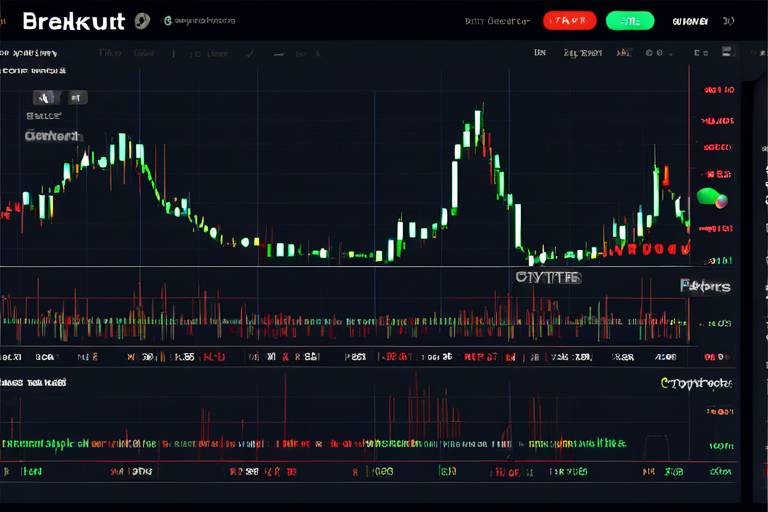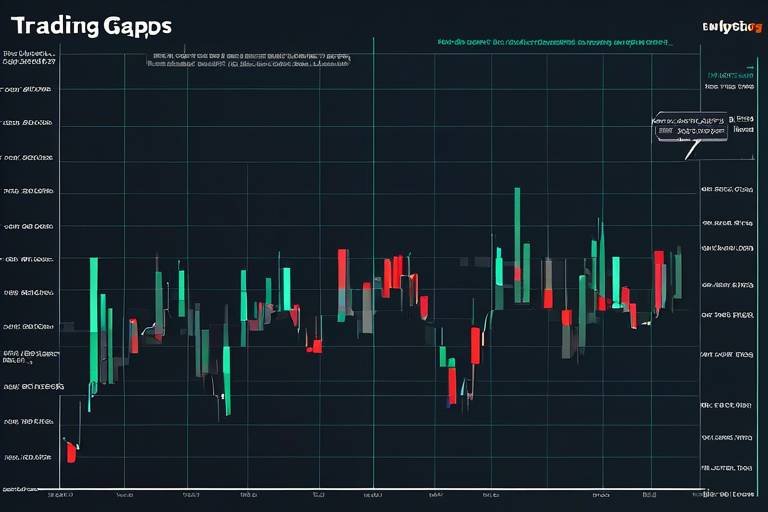How to Identify Seasonal Patterns in Cryptocurrency Prices
Understanding the ebbs and flows of cryptocurrency prices can often feel like trying to catch smoke with your bare hands. However, by identifying seasonal patterns, traders can transform this elusive task into a more manageable and predictable endeavor. Just like the changing of the seasons affects the natural world, the cryptocurrency market also experiences cyclical trends that can be traced and anticipated. In this article, we will explore various methods and techniques to recognize these seasonal trends, which can significantly enhance trading strategies and investment decisions for both novices and experienced traders alike.
So, what exactly are seasonal trends? In the world of cryptocurrency, these refer to predictable price movements that occur during specific times of the year. Imagine planting a garden; you wouldn't expect to harvest tomatoes in winter, right? Similarly, recognizing these patterns can help investors make informed decisions and optimize their trading strategies based on historical data. By understanding when cryptocurrencies typically rise or fall, traders can position themselves to take advantage of these fluctuations, ultimately leading to better returns on investment.
One of the most critical aspects of identifying seasonal patterns is analyzing historical price data. By examining past price movements, traders can uncover trends that may repeat in future market cycles. This analysis provides valuable insights for investment strategies, akin to studying the weather patterns before planning an outdoor event. To effectively analyze historical data, it's essential to utilize reliable sources that offer accurate information. After all, a solid foundation is key to making sound investment decisions.
Various platforms provide historical cryptocurrency data, including exchanges and market analysis websites. Utilizing these reliable sources ensures accurate analysis and enhances the credibility of identified seasonal trends. Here are a few popular sources:
- CoinMarketCap
- CoinGecko
- CryptoCompare
- Exchange-specific data (e.g., Binance, Coinbase)
Data from cryptocurrency exchanges often provides the most comprehensive insights into price trends. Analyzing this data can reveal specific patterns tied to trading volume and market sentiment. For instance, you might notice that certain cryptocurrencies tend to spike in price during the holiday season, driven by increased consumer interest and investment. By keeping an eye on exchange data, traders can better understand these dynamics and adjust their strategies accordingly.
Utilizing advanced market analysis tools can help visualize historical price movements. These tools often offer features like charting and technical indicators, making it easier to spot seasonal trends. Think of these tools as your personal weather radar, providing insights into upcoming market conditions. Some popular tools include:
- TradingView
- Coinigy
- Crypto Pro
Certain indicators can signal the presence of seasonal patterns. Recognizing these indicators can assist traders in timing their trades effectively to capitalize on predictable price movements. For example, if you notice a consistent uptick in prices around a specific holiday or event, this could be a sign to prepare for a similar trend in the future. By paying attention to these indicators, traders can sharpen their instincts and make more informed decisions.
Market sentiment plays a significant role in influencing seasonal trends. Understanding how investor emotions and behaviors shift during different times of the year can enhance the accuracy of seasonal pattern identification. For instance, during bull markets, investors may feel more optimistic and inclined to buy, while during bear markets, fear and uncertainty may prevail, leading to sell-offs. Recognizing these emotional shifts can be the difference between riding a wave of profit and getting caught in a downturn.
Studying investor behavior during specific seasons can provide insights into market sentiment. This analysis can help traders anticipate potential price movements based on historical reactions to market events. For example, if historical data shows that a particular cryptocurrency tends to perform well during tax season, traders can prepare to capitalize on this trend.
Major events, such as regulatory changes or technological advancements, can disrupt seasonal patterns. Recognizing these events and their potential impacts can help traders adjust their strategies accordingly. Just like a sudden rainstorm can change your plans for a picnic, unexpected market developments can significantly affect cryptocurrency prices. Staying informed about global news and events is crucial for any trader looking to navigate the complex waters of cryptocurrency investing.
Implementing strategies based on identified seasonal patterns can lead to more successful trading outcomes. This section discusses practical approaches to leverage these patterns for maximizing profits and minimizing risks. By understanding when to enter or exit positions, traders can align their strategies with predicted price movements, much like timing a perfect wave while surfing.
Effective timing is crucial in trading. By understanding seasonal patterns, traders can better determine when to enter or exit positions. For example, if historical data indicates a price increase leading up to a major event, a trader might choose to buy before the event and sell shortly after. This strategy can help maximize profits while minimizing the risk of holding assets during uncertain times.
Incorporating risk management strategies is essential when trading based on seasonal patterns. This approach helps protect investments from unexpected market fluctuations while capitalizing on seasonal trends. Setting stop-loss orders, diversifying portfolios, and continuously monitoring market conditions are just a few ways traders can safeguard their investments. Remember, in the world of cryptocurrency, it's better to be safe than sorry!
Q1: How can I start analyzing seasonal patterns in cryptocurrency?
A1: Begin by gathering historical price data from reliable sources and utilize market analysis tools to visualize trends. Look for consistent price movements during specific times of the year.
Q2: Are seasonal patterns guaranteed to repeat?
A2: While seasonal patterns can provide valuable insights, they are not guaranteed. Market conditions can change due to various factors, so it's essential to remain vigilant and adaptable.
Q3: How can I manage risks when trading based on seasonal patterns?
A3: Incorporate risk management strategies such as setting stop-loss orders, diversifying your portfolio, and continuously monitoring market conditions to protect your investments.

Understanding Seasonal Trends
When it comes to the world of cryptocurrency, understanding seasonal trends can be as essential as knowing the latest market news. Just like the seasons change in nature, cryptocurrency prices often exhibit predictable movements during specific times of the year. Imagine you're a farmer; you wouldn't plant your crops in winter, right? Similarly, in trading, recognizing the right time to invest can make all the difference between profit and loss.
Seasonal trends are not just random fluctuations; they are predictable price movements that occur consistently over time. For instance, many traders have observed that Bitcoin tends to perform well in the fourth quarter of the year, often leading to a surge in prices as the holiday season approaches. This pattern can be attributed to various factors, including increased media attention and a rush of new investors entering the market. By understanding these trends, traders can make more informed decisions and optimize their strategies.
To grasp the concept of seasonal trends fully, it's crucial to dive into the historical data. Analyzing past price movements can reveal patterns that are likely to repeat in future market cycles. This is where the magic happens! By examining how prices reacted during certain periods—like the new year, tax season, or major market events—traders can uncover valuable insights. For example, some traders notice a dip in prices during the summer months, which could be linked to lower trading volumes as many take vacations.
Moreover, understanding seasonal trends involves recognizing the influence of external factors. For instance, market sentiment can shift dramatically based on news, regulatory changes, or technological advancements, which can either reinforce or disrupt established seasonal patterns. Therefore, keeping an eye on both historical data and current events is vital for any trader looking to capitalize on these trends.
In summary, grasping the concept of seasonal trends in cryptocurrency is akin to reading the weather forecast before planning a trip. It equips traders with the knowledge to navigate the often unpredictable market landscape. By analyzing historical data, recognizing external influences, and understanding the cyclical nature of price movements, traders can enhance their investment strategies and improve their chances of success.

Historical Data Analysis
When it comes to identifying seasonal patterns in cryptocurrency prices, analyzing historical data is like having a treasure map. It leads you to insights that can significantly enhance your trading strategies. By diving into past price movements, traders can uncover trends that have the potential to repeat themselves in future market cycles. This exploration isn’t just about numbers; it’s about understanding the story they tell. For instance, did Bitcoin's price tend to rise every December? Or did Ethereum see a slump every July? These are the kinds of questions that historical data analysis can help answer.
To get started, you need to know where to find reliable historical data. Various platforms provide access to this goldmine of information, including cryptocurrency exchanges and dedicated market analysis websites. Utilizing these sources ensures that your analysis is accurate and credible. After all, what’s the point of a map that leads you astray?
Among the most valuable resources for historical data are cryptocurrency exchanges. These platforms often provide extensive datasets that include not just prices, but also trading volumes, which can be crucial for understanding market sentiment. When analyzing this data, you might notice specific patterns tied to trading volume and price fluctuations. For instance, a spike in trading volume often correlates with significant price movements, which can be a telltale sign of an impending seasonal trend.
Another powerful tool in your arsenal is market analysis software. These tools come equipped with features like charting and technical indicators, allowing you to visualize historical price movements more effectively. Imagine trying to find a pattern in a long string of numbers—it's like looking for a needle in a haystack! But with the right tools, you can create clear graphs that illustrate these patterns, making it easier to spot seasonal trends. Here’s a simple table that summarizes some popular data sources:
| Data Source | Description | Website |
|---|---|---|
| CoinMarketCap | Offers comprehensive historical price data for various cryptocurrencies. | coinmarketcap.com |
| Binance | One of the largest exchanges, providing extensive trading data. | binance.com |
| TradingView | Advanced charting tools and community-driven insights. | tradingview.com |
In summary, the analysis of historical data is not just a step—it’s a vital part of the journey in recognizing seasonal patterns in cryptocurrency prices. By leveraging reliable data sources and utilizing advanced analysis tools, traders can uncover trends that not only inform their strategies but also give them a competitive edge in the ever-evolving crypto landscape.

Data Sources for Analysis
When diving into the world of cryptocurrency, one of the most crucial steps in identifying seasonal patterns is sourcing reliable data. The right data can make the difference between a successful trade and a costly mistake. So, where do you find this golden information? Let’s break down some of the most effective sources for historical cryptocurrency data.
First off, cryptocurrency exchanges are a primary source for historical price data. Major exchanges like Binance, Coinbase, and Kraken not only provide real-time trading data but also offer extensive historical records. These platforms allow users to analyze price movements and trading volumes over various time frames, from minutes to years. By studying this data, traders can uncover trends and patterns that have emerged in the past, which may repeat in the future.
Another excellent source is market analysis websites. Websites such as CoinMarketCap and CoinGecko aggregate data from multiple exchanges, providing a broader view of market trends. These platforms often feature advanced filtering options, allowing traders to compare different cryptocurrencies and their historical performances. Additionally, they provide useful visualizations, such as graphs and charts, which can make spotting seasonal trends much easier.
Moreover, utilizing API services can be a game-changer for traders who wish to conduct in-depth analysis. APIs from services like CryptoCompare and Nomics allow users to programmatically access historical data, enabling them to perform custom analyses and create tailored trading strategies. This flexibility can be particularly beneficial for those who are more technically inclined and wish to automate their trading processes.
To further enrich your analysis, consider using technical analysis tools. Platforms like TradingView and MetaTrader offer sophisticated charting capabilities and a variety of technical indicators. These tools can help visualize historical price movements, making it easier to identify patterns and trends. The ability to overlay multiple indicators can provide deeper insights into potential seasonal movements.
In summary, leveraging a combination of these data sources can significantly enhance your ability to identify seasonal patterns in cryptocurrency prices. Whether you’re pulling data from exchanges, utilizing market analysis websites, or employing sophisticated technical analysis tools, the key is to ensure that your data is accurate and reliable. This will not only boost your confidence in your findings but also empower you to make informed trading decisions.
- What are the best cryptocurrency exchanges for historical data? Major exchanges like Binance, Coinbase, and Kraken are recommended for comprehensive historical data.
- How can I automate my data analysis? Utilizing APIs from services like CryptoCompare and Nomics allows for automated data retrieval and analysis.
- What tools can help visualize cryptocurrency price trends? Tools like TradingView and MetaTrader offer robust charting features to help visualize price movements.

Exchange Data
When it comes to identifying seasonal patterns in cryptocurrency prices, serves as a treasure trove of insights. The data obtained from various cryptocurrency exchanges is often the most comprehensive and reliable source for understanding price movements. These exchanges provide real-time trading information, historical price data, and trading volumes that can reveal underlying trends. By analyzing this data, traders can uncover specific patterns that correlate with seasonal fluctuations, allowing them to make more informed decisions.
For instance, let’s consider how trading volume can affect price trends. During certain times of the year, such as the holiday season or tax season, trading volumes may spike due to increased investor activity. This spike can lead to significant price changes, making it vital for traders to monitor exchange data closely. Moreover, market sentiment can also be gauged through this data, as higher volumes often indicate increased interest and confidence among traders.
In addition to trading volumes, exchange data can also provide insights into market sentiment. By analyzing the buy and sell orders, traders can gauge whether the market is leaning towards bullish or bearish trends. This sentiment analysis can be crucial for timing trades effectively. For example, if a trader notices a surge in buy orders during a particular season, it might indicate a bullish trend, prompting them to enter the market.
To make the most of exchange data, traders should focus on a few key metrics:
- Price Movements: Tracking how prices have changed over time during specific seasons.
- Trading Volume: Monitoring the amount of cryptocurrency traded to identify spikes in activity.
- Order Book Data: Analyzing the buy and sell orders to assess market sentiment.
By synthesizing these elements, traders can develop a clearer picture of how seasonal patterns might influence future price movements. The key is to not just look at the numbers but to interpret what they mean in the context of broader market trends. This nuanced understanding can significantly enhance a trader's ability to predict price changes and optimize their trading strategies.
- What is exchange data? Exchange data refers to the information gathered from cryptocurrency exchanges, including historical prices, trading volumes, and order book data.
- How can exchange data help in trading? By analyzing exchange data, traders can identify seasonal patterns, gauge market sentiment, and make informed trading decisions.
- Are all exchanges reliable for data analysis? Not all exchanges provide the same level of data quality. It's essential to use reputable exchanges known for their accurate and comprehensive data.
- What other factors should I consider alongside exchange data? Consider market sentiment, major events, and macroeconomic factors that could influence cryptocurrency prices.

Market Analysis Tools
When it comes to navigating the tumultuous waters of cryptocurrency trading, having the right at your disposal can make a world of difference. These tools not only help in visualizing historical price movements but also empower traders to make informed decisions based on data rather than mere speculation. Think of them as your trusty compass in the unpredictable seas of the crypto market, guiding you towards potential profits while steering you away from losses.
One of the most popular types of market analysis tools are charting platforms. These platforms provide a visual representation of price movements over time, allowing traders to identify trends and patterns more easily. For instance, you might notice that Bitcoin tends to surge around the holiday season, a trend that could influence your trading strategy. By using these charts, you can pinpoint key support and resistance levels, which are critical for making educated trading decisions.
Additionally, many of these charting platforms come equipped with technical indicators that can further enhance your analysis. Indicators like Moving Averages, Relative Strength Index (RSI), and Bollinger Bands can help you assess market momentum and volatility. By combining these indicators with historical data, you can create a more comprehensive view of the market's behavior. For example, if the RSI indicates that a cryptocurrency is overbought, it might be a signal to consider taking profits or tightening your stop-loss orders.
Another facet of market analysis tools is the availability of real-time data feeds. These feeds provide up-to-the-minute information on price changes, trading volume, and market capitalization. Having access to real-time data is crucial because the cryptocurrency market operates 24/7, and prices can fluctuate dramatically in a matter of minutes. By staying updated with real-time data, you can react swiftly to market changes and capitalize on short-term opportunities.
Moreover, many traders find it beneficial to use portfolio management tools that allow them to track their investments and analyze their performance. These tools can aggregate data from multiple exchanges and wallets, giving you a holistic view of your portfolio. You can assess which investments are performing well and which ones may need to be re-evaluated. This is especially important in a market as volatile as cryptocurrency, where quick adjustments can mean the difference between profit and loss.
To summarize, utilizing market analysis tools is essential for anyone serious about trading cryptocurrencies. By leveraging charting platforms, technical indicators, real-time data feeds, and portfolio management tools, traders can enhance their understanding of market dynamics and improve their trading strategies. Remember, in the world of cryptocurrency, knowledge is power, and the right tools can provide you with the insights needed to navigate this complex landscape.
- What are the best market analysis tools for cryptocurrency trading? There are several reputable tools like TradingView, CoinMarketCap, and CryptoCompare that offer comprehensive charting and analysis features.
- How do I choose the right indicators for my trading strategy? The choice of indicators depends on your trading style. For instance, day traders might prefer momentum indicators, while long-term investors might focus on trend indicators.
- Can I use market analysis tools for free? Yes, many platforms offer free versions with basic features, but premium features may require a subscription.

Identifying Key Seasonal Indicators
When it comes to identifying key seasonal indicators in cryptocurrency markets, it’s like being a detective on the hunt for clues. These indicators serve as vital signs that can help traders understand the rhythm of the market. Just as musicians rely on a metronome to keep time, traders can use these indicators to synchronize their strategies with the market's seasonal beats. One of the most effective ways to spot these indicators is by analyzing price movements over specific periods. For instance, if you notice that a particular cryptocurrency tends to spike in value every December, that could signal a recurring seasonal trend.
Another important aspect is to pay attention to trading volume. Increased trading activity often accompanies significant price movements, and these spikes can be indicative of seasonal trends. Think of it like a wave: when the tide rises, it can lift all boats, but when it ebbs, some may be left stranded. By monitoring trading volume alongside price changes, traders can gain insights into market sentiment and potential price shifts.
Additionally, you can look for patterns in market sentiment during specific times of the year. For example, during tax season in the U.S., there may be increased selling pressure as investors liquidate assets to pay their taxes. This could lead to a predictable dip in prices during that period. Conversely, holiday seasons or major events in the crypto calendar, such as Bitcoin halving, can lead to bullish trends. Recognizing these seasonal sentiments can help traders anticipate market movements.
To further aid in identifying these indicators, many traders rely on technical analysis tools. These tools can help visualize price movements and highlight seasonal trends through various chart patterns and indicators. For example, using moving averages can smooth out price data and reveal underlying trends that might not be immediately apparent in raw data. By combining technical analysis with historical price data, traders can develop a comprehensive view of seasonal patterns.
In summary, identifying key seasonal indicators involves a mix of analyzing price movements, monitoring trading volume, and understanding market sentiment. By honing in on these indicators, traders can enhance their strategies and improve their chances of making profitable trades. Just remember, the market is always evolving, so staying updated and flexible is essential for success.
- What are seasonal patterns in cryptocurrency? Seasonal patterns refer to predictable price movements that occur during specific times of the year, influenced by various factors such as market sentiment and historical trends.
- How can I identify seasonal trends? You can identify seasonal trends by analyzing historical price data, monitoring trading volumes, and utilizing technical analysis tools to visualize patterns.
- Why is market sentiment important for seasonal patterns? Market sentiment reflects investor emotions and behaviors, which can significantly influence price movements. Understanding these sentiments helps traders make informed decisions.
- Can major events disrupt seasonal patterns? Yes, major events such as regulatory changes or technological advancements can disrupt established seasonal patterns, making it essential for traders to stay informed and adjust their strategies accordingly.

Market Sentiment and Seasonal Patterns
Market sentiment is like the *heartbeat* of the cryptocurrency world. It reflects the collective feelings and attitudes of investors towards a particular asset or the market as a whole. Understanding how this sentiment shifts throughout the year can be a game-changer for traders looking to capitalize on seasonal patterns. Just think of it as reading the room before making your move; if you know how people are feeling, you can make better decisions.
During specific times of the year, such as holidays or significant market events, investor emotions can swing dramatically. For example, around the holiday season, many investors might feel optimistic, leading to increased buying activity. Conversely, during tax season, the sentiment may shift to caution as individuals liquidate their assets to pay taxes. These emotional swings can create predictable price movements, allowing traders to position themselves advantageously.
To truly harness the power of market sentiment, it's essential to conduct a thorough behavioral analysis. This involves looking at past investor reactions to similar seasonal events. For instance, if you notice that Bitcoin tends to rise consistently in December, it could be due to holiday spending or year-end investment strategies. By studying these patterns, traders can anticipate future movements and make informed decisions.
However, it’s crucial to remember that major events can disrupt these seasonal trends. Regulatory changes, technological advancements, or even geopolitical events can send shockwaves through the market, altering investor sentiment almost overnight. For example, if a government announces stricter regulations on cryptocurrency trading, you might see a sudden drop in prices, regardless of the time of year. This unpredictability is why staying informed about current events is just as important as analyzing historical data.
In summary, understanding market sentiment is key to identifying and leveraging seasonal patterns in cryptocurrency trading. By being aware of how emotions and behaviors shift throughout the year, traders can better time their trades and enhance their overall strategies. After all, in the fast-paced world of cryptocurrency, being in tune with the market’s pulse can mean the difference between a successful trade and a missed opportunity.

Behavioral Analysis
When it comes to trading cryptocurrencies, understanding investor behavior during specific seasons can be a game-changer. Think of it like a dance; every year, traders move in rhythm with the market, often swayed by emotions, news, and trends. By analyzing these behaviors, traders can anticipate potential price movements and make more informed decisions.
For instance, during the holiday season, many investors may feel optimistic, leading to increased buying activity. This surge in enthusiasm can drive prices up, creating a seasonal trend. On the flip side, the post-holiday slump often sees a decline in prices as traders take profits or cash out, which can signal a seasonal dip. Recognizing such patterns can help traders align their strategies with market sentiment.
Moreover, it’s crucial to consider how external factors influence these seasonal behaviors. Events like tax season can trigger selling as investors liquidate their assets to cover liabilities. Similarly, the excitement surrounding major cryptocurrency conferences or technological advancements can lead to bullish sentiment, causing prices to soar. By keeping an eye on these events and their historical impacts, traders can better predict future movements.
To illustrate the importance of behavioral analysis, let’s look at a simple table that outlines typical seasonal behaviors:
| Season | Behavior | Potential Price Movement |
|---|---|---|
| Winter Holidays | Increased buying due to optimism | Price rise |
| Post-Holidays | Profit-taking and selling | Price decline |
| Tax Season | Liquidation of assets | Price drop |
| Major Events | Heightened interest and buying | Price surge |
In summary, a thorough behavioral analysis can provide traders with a significant edge in the cryptocurrency market. By understanding how psychological factors and external events influence trading behavior, investors can better navigate the unpredictable waters of cryptocurrency trading. This awareness not only enhances their ability to spot seasonal patterns but also empowers them to make strategic decisions that align with market sentiment.
- What is behavioral analysis in cryptocurrency trading?
Behavioral analysis involves studying the emotional and psychological factors that influence investor decisions in the cryptocurrency market. - How can seasonal trends affect my trading strategy?
Recognizing seasonal trends can help you time your trades better, allowing you to capitalize on predictable price movements. - What are some common seasonal patterns in cryptocurrency?
Common patterns include increased buying during the holiday season and selling during tax season. - How can I stay updated on major events that impact the market?
Following cryptocurrency news outlets, social media, and market analysis platforms can keep you informed about significant events.

Impact of Major Events
The cryptocurrency market is notoriously volatile, and one of the significant factors contributing to this volatility is the impact of major events. These events can range from regulatory announcements, technological advancements, to macroeconomic changes. Each of these occurrences can create ripples that affect market sentiment and, consequently, seasonal price patterns. For instance, when a country announces new regulations regarding cryptocurrency trading, it can lead to sudden price drops or spikes, depending on the nature of the news.
Understanding how these events influence seasonal trends is crucial for traders aiming to make informed decisions. Major events often disrupt established patterns, making it essential for traders to remain vigilant and adaptable. For example, if a major exchange experiences a security breach, the market may react negatively, overshadowing any positive seasonal trends that were previously observed. This unpredictability underscores the importance of not only recognizing seasonal patterns but also being aware of the external factors that can influence them.
Moreover, the timing of these events can coincide with specific seasons, amplifying their effects. For example, if a significant technological advancement, like the implementation of a new blockchain protocol, is announced during a historically bullish season, the positive sentiment could lead to unprecedented price increases. Conversely, if the same event occurs during a bearish season, it might not have the desired effect. Thus, traders should consider both the nature of the event and the seasonal context in which it occurs.
To illustrate this further, consider the following table that outlines some common major events and their potential impacts on cryptocurrency prices:
| Event Type | Description | Potential Impact |
|---|---|---|
| Regulatory Changes | Government announcements regarding cryptocurrency regulations | Can lead to price drops or spikes depending on the nature of the regulation |
| Technological Advancements | Launch of new blockchain technologies or updates | Can boost prices if perceived positively, or have minimal effect if in a bearish season |
| Market Crashes | Global economic downturns affecting investor confidence | Typically leads to price declines across the board |
| Security Breaches | Hacks or security failures in major exchanges | Can cause immediate price drops and long-term trust issues |
In summary, while seasonal patterns can provide valuable insights for traders, the influence of major events cannot be overlooked. By staying informed about potential market-moving events and understanding their historical impacts, traders can develop more robust strategies that incorporate both seasonal trends and external factors. This holistic approach not only enhances trading effectiveness but also prepares investors for the unexpected twists and turns that characterize the cryptocurrency landscape.
- What are seasonal patterns in cryptocurrency? Seasonal patterns refer to predictable price movements that occur during specific times of the year based on historical data.
- How can major events affect seasonal patterns? Major events can disrupt established seasonal trends, causing volatility and unexpected price movements.
- What types of major events should traders watch for? Traders should monitor regulatory changes, technological advancements, market crashes, and security breaches.
- How can I prepare for the impact of major events? Stay informed about the market, analyze historical data, and develop flexible trading strategies that can adapt to sudden changes.

Practical Application of Seasonal Patterns
Understanding and applying seasonal patterns in cryptocurrency trading can be a game-changer. Imagine you’re a surfer waiting for the perfect wave; you wouldn’t just paddle out randomly, right? You’d study the tides, the winds, and the seasons to catch that ideal ride. Similarly, by recognizing seasonal trends in the crypto market, traders can enhance their decision-making processes and improve their overall profitability.
One of the most effective ways to leverage these patterns is by timing your trades. For instance, if historical data shows that Bitcoin tends to rise in value during the holiday season, savvy traders can plan their purchases ahead of time. This proactive approach allows them to capitalize on predictable price movements. Think of it like planting a seed in spring; with the right conditions, you can expect a bountiful harvest in summer.
However, timing is not just about knowing when to buy; it’s equally important to know when to sell. Seasonal patterns can indicate optimal exit points as well. For example, if a trader notices a consistent dip in prices following a seasonal peak, they can strategically sell their assets to maximize profits. This practice is akin to selling lemonade at the peak of a hot summer day—waiting too long might mean missing out on the best sales!
Another crucial aspect of applying seasonal patterns is incorporating risk management strategies. The crypto market can be notoriously volatile, and unexpected events can disrupt even the most well-planned strategies. By understanding seasonal trends, traders can set appropriate stop-loss orders or adjust their investment sizes accordingly. For instance, if a trader anticipates a seasonal downturn, they might decide to reduce their exposure to minimize potential losses.
To illustrate the practical application of seasonal patterns, consider the following table that outlines some common seasonal trends in major cryptocurrencies:
| Cryptocurrency | Seasonal Trend | Best Months to Buy | Best Months to Sell |
|---|---|---|---|
| Bitcoin | Increased demand during holidays | November - December | January - February |
| Ethereum | Price surge during major upgrades | May - June | September |
| Litecoin | Price spikes during halving events | Three months before halving | Immediately after halving |
By utilizing such data, traders can make informed decisions that align with historical trends. It’s like having a map that shows you the best routes to take on your journey; you’re less likely to get lost and more likely to reach your destination successfully.
In conclusion, the practical application of seasonal patterns in cryptocurrency trading is not just about understanding when to buy or sell; it’s about creating a comprehensive strategy that incorporates timing, risk management, and continuous analysis of market trends. So, as you venture into the crypto waters, remember to keep an eye on the seasonal tides—they might just lead you to your next big opportunity!
- What are seasonal patterns in cryptocurrency? Seasonal patterns are predictable price movements that occur during specific times of the year, influenced by various factors including market sentiment and investor behavior.
- How can I identify seasonal trends? By analyzing historical price data, utilizing market analysis tools, and observing key seasonal indicators, traders can identify and leverage these trends for better trading strategies.
- Are seasonal patterns reliable? While they can provide valuable insights, it's essential to remember that the cryptocurrency market is volatile, and unexpected events can disrupt these patterns.

Timing Your Trades
Timing your trades effectively can make all the difference in the volatile world of cryptocurrency. Understanding seasonal patterns allows traders to pinpoint the optimal moments to enter or exit the market, enhancing the potential for profit. Imagine you’re a surfer waiting for the perfect wave; you wouldn’t just paddle out at any time, right? You’d want to catch that wave at just the right moment to ride it all the way to the shore. Similarly, in trading, timing is everything.
One of the key aspects of timing your trades is recognizing the cyclical nature of cryptocurrency prices. For instance, many cryptocurrencies tend to experience price surges during certain months of the year. By analyzing historical data, you can identify these trends and align your trading strategy accordingly. For example, if you notice that Bitcoin often sees an uptick in prices around December due to holiday shopping and increased investor interest, you might consider entering a position in November to maximize your gains.
Moreover, it's essential to keep an eye on market sentiment during these seasonal peaks. Investor psychology can significantly impact prices; when people are generally optimistic, prices tend to rise. Conversely, during bearish seasons, even the slightest negative news can trigger a sell-off. To navigate these emotional waters effectively, you might want to employ some technical analysis tools that can help visualize market trends and sentiment shifts. A good practice is to combine these insights with your seasonal analysis to make more informed decisions.
Here’s a simple table summarizing some common seasonal trends in cryptocurrency trading:
| Month | Typical Trend | Reason |
|---|---|---|
| January | Price Growth | New Year investments and optimism |
| June | Market Correction | Mid-year profit-taking |
| December | Price Surge | Holiday season buying |
In addition to understanding seasonal trends, consider employing a strategy known as dollar-cost averaging (DCA). This approach involves investing a fixed amount of money at regular intervals, regardless of the price. It’s like planting seeds in your garden at different times of the year; you’re not just relying on one season for your harvest. DCA can help mitigate the risks associated with timing the market, as it allows you to benefit from both highs and lows over time.
Ultimately, the key to successful trading lies in combining your understanding of seasonal patterns with sound risk management strategies. By setting stop-loss orders and taking profits when appropriate, you can protect your investments while still capitalizing on the seasonal opportunities that arise. Remember, the market is ever-changing, and staying informed and adaptable is crucial for long-term success.
- What are seasonal patterns in cryptocurrency? Seasonal patterns refer to predictable price movements that tend to occur at specific times of the year based on historical data.
- How can I identify seasonal trends? You can identify seasonal trends by analyzing historical price data, looking for recurring patterns during specific months or events.
- Why is timing important in cryptocurrency trading? Timing is crucial because entering or exiting a position at the right moment can significantly impact your potential profits and losses.
- What is dollar-cost averaging? Dollar-cost averaging is an investment strategy where you invest a fixed amount of money at regular intervals, reducing the impact of volatility.

Risk Management Strategies
When it comes to trading cryptocurrencies, risk management is not just a strategy—it's a necessity. The volatile nature of these digital assets means that prices can swing dramatically in short periods. Therefore, having a robust risk management plan in place can be the difference between a successful trade and a devastating loss. One of the most effective ways to manage risk is through the use of stop-loss orders. These orders automatically sell your cryptocurrency once it reaches a certain price, helping to minimize potential losses. Imagine you bought Bitcoin at $40,000, and you set a stop-loss order at $38,000. If the price drops to that level, your order will execute, protecting your investment from further decline.
Another essential aspect of risk management is diversifying your portfolio. By spreading your investments across different cryptocurrencies, you reduce the impact of a poor-performing asset on your overall portfolio. For example, if you invest in Bitcoin, Ethereum, and Litecoin, a drop in one may be offset by gains in another. This strategy is akin to not putting all your eggs in one basket—if one basket falls, you still have others to rely on.
Additionally, it's crucial to determine your risk tolerance before entering any trade. Ask yourself how much you are willing to lose on a single trade and adjust your position sizes accordingly. A common rule of thumb is to risk no more than 1-2% of your total trading capital on any given trade. This way, even if you encounter a series of losses, your overall portfolio remains intact, allowing you to trade another day.
Moreover, keeping an eye on market conditions and adjusting your strategies accordingly can also help mitigate risks. For instance, if you notice significant market volatility or unfavorable news affecting the cryptocurrency landscape, it might be wise to tighten your stop-loss orders or even sit out of trading until conditions stabilize.
To summarize, effective risk management strategies in cryptocurrency trading include:
- Utilizing stop-loss orders to protect against significant losses.
- Diversifying your portfolio to spread risk across multiple assets.
- Determining your risk tolerance and adjusting position sizes accordingly.
- Monitoring market conditions and adapting your strategies as needed.
By integrating these risk management strategies into your trading approach, you can enhance your ability to navigate the unpredictable world of cryptocurrencies while maximizing your potential for profit. Remember, it's not just about making money; it's about protecting what you have while you grow it.
- What is risk management in cryptocurrency trading?
Risk management in cryptocurrency trading involves strategies and techniques designed to minimize potential losses while maximizing potential profits. - How can I determine my risk tolerance?
Your risk tolerance can be determined by assessing your financial situation, investment goals, and how much loss you can comfortably handle. - What are stop-loss orders?
Stop-loss orders are automatic sell orders that execute when a cryptocurrency reaches a specified price, helping to limit losses. - Is diversification important in cryptocurrency?
Yes, diversification is crucial as it helps spread risk across various assets, reducing the impact of any single asset's poor performance.
Frequently Asked Questions
- What are seasonal trends in cryptocurrency prices?
Seasonal trends refer to predictable price movements that occur during specific times of the year. By identifying these trends, traders can make informed decisions and optimize their strategies based on historical data.
- How can I analyze historical data to identify seasonal patterns?
Analyzing historical price data is essential for spotting seasonal patterns. Traders can examine past price movements through various data sources, such as cryptocurrency exchanges and market analysis websites, to uncover trends that might repeat in future market cycles.
- What data sources are reliable for historical cryptocurrency analysis?
Reliable data sources include cryptocurrency exchanges and market analysis platforms. These sources provide comprehensive insights into price trends, which are crucial for accurate seasonal pattern analysis.
- What key indicators should I look for when identifying seasonal patterns?
Certain indicators, such as trading volume and market sentiment, can signal the presence of seasonal patterns. Recognizing these indicators helps traders time their trades effectively, capitalizing on predictable price movements.
- How does market sentiment impact seasonal trends?
Market sentiment significantly influences seasonal trends. Understanding how investor emotions and behaviors shift during different times of the year can enhance the accuracy of identifying these patterns, allowing traders to anticipate potential price movements.
- What role do major events play in disrupting seasonal patterns?
Major events, like regulatory changes or technological advancements, can disrupt established seasonal patterns. Being aware of these events and their potential impacts allows traders to adjust their strategies accordingly to mitigate risks.
- How can I practically apply seasonal patterns in my trading strategy?
To leverage seasonal patterns effectively, traders should focus on timing their trades and incorporating risk management strategies. This approach helps maximize profits while minimizing risks associated with unexpected market fluctuations.
- What are some effective risk management strategies when trading based on seasonal patterns?
Incorporating stop-loss orders, diversifying investments, and setting realistic profit targets are effective risk management strategies. These measures protect investments from unforeseen market changes while capitalizing on identified seasonal trends.



















